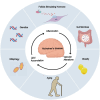From hormones to neurodegeneration: how FSH drives Alzheimer's disease
- PMID: 40589620
- PMCID: PMC12206753
- DOI: 10.3389/fnagi.2025.1578439
From hormones to neurodegeneration: how FSH drives Alzheimer's disease
Abstract
The role and function of follicle-stimulating hormone in the gonads have been extremely studied. However, recent research has begun to explore the relationship between elevated follicle-stimulating hormone levels and the prevalence of extragonadal disorders, particularly in perimenopausal and postmenopausal women. These disorders include endometrial cancer, osteoporosis, obesity, and atherosclerosis. This review provides new insights into the relationship between follicle-stimulating hormone and the development of age-related diseases, with a focus on Alzheimer's disease. Follicle-stimulating hormone does not act alone in promoting Alzheimer's disease but often works in conjunction with inflammation, lipid accumulation, and vascular alterations. Furthermore, follicle-stimulating hormone synergizes with obesity, gut microbiota, autophagy, and aging, creating conditions that facilitate the onset and progression of Alzheimer's disease. This review also summarizes the therapeutic potential of FSH-blocking antibodies in treating these diseases.
Keywords: Alzheimer’s disease; FSH-blocking antibodies; aging; follicle-stimulating hormone; lipid accumulation; neuroinflammation.
Copyright © 2025 Xue, Zuo, Wang and Qi.
Conflict of interest statement
The authors declare that the research was conducted in the absence of any commercial or financial relationships that could be construed as a potential conflict of interest.
Figures



Similar articles
-
Individualised gonadotropin dose selection using markers of ovarian reserve for women undergoing in vitro fertilisation plus intracytoplasmic sperm injection (IVF/ICSI).Cochrane Database Syst Rev. 2018 Feb 1;2(2):CD012693. doi: 10.1002/14651858.CD012693.pub2. Cochrane Database Syst Rev. 2018. Update in: Cochrane Database Syst Rev. 2024 Jan 4;1:CD012693. doi: 10.1002/14651858.CD012693.pub3. PMID: 29388198 Free PMC article. Updated.
-
Randomized controlled trial to evaluate the impact of follicle priming on IVM outcomes in women with polycystic ovaries: CFA versus FSH-B.Hum Reprod. 2025 Jun 1;40(6):1127-1137. doi: 10.1093/humrep/deaf053. Hum Reprod. 2025. PMID: 40194780 Clinical Trial.
-
CSF tau and the CSF tau/ABeta ratio for the diagnosis of Alzheimer's disease dementia and other dementias in people with mild cognitive impairment (MCI).Cochrane Database Syst Rev. 2017 Mar 22;3(3):CD010803. doi: 10.1002/14651858.CD010803.pub2. Cochrane Database Syst Rev. 2017. PMID: 28328043 Free PMC article.
-
Long-term hormone therapy for perimenopausal and postmenopausal women.Cochrane Database Syst Rev. 2017 Jan 17;1(1):CD004143. doi: 10.1002/14651858.CD004143.pub5. Cochrane Database Syst Rev. 2017. PMID: 28093732 Free PMC article.
-
Relationship between Pituitary Gland and Stem Cell in the Aspect of Hormone Production and Disease Prevention: A Narrative Review.Endocr Metab Immune Disord Drug Targets. 2025;25(7):509-526. doi: 10.2174/0118715303314551241031093717. Endocr Metab Immune Disord Drug Targets. 2025. PMID: 39812047 Review.
References
-
- Apatiga-Perez R., Soto-Rojas L. O., Campa-Cordoba B. B., Luna-Viramontes N. I., Cuevas E., Villanueva-Fierro I., et al. (2022). Neurovascular dysfunction and vascular amyloid accumulation as early events in Alzheimer's disease. Metab. Brain Dis. 37, 39–50. doi: 10.1007/s11011-021-00814-4, PMID: - DOI - PubMed
Publication types
LinkOut - more resources
Full Text Sources

